Automakers the world over are facing a 2025 deadline to reduce emissions, thanks to a 2011 Corporate Average Fuel Economy (CAFE) agreement.
Their strategies vary. Many, like BMW, are banking on PHEVs – plug-in hybrid electric vehicles. BMW will even electrify its M lineup of performance variants.
The Bavarian Motor Works is already spreading its “e” technology throughout its lineup. For instance, the 330e was a treat to drive. The X5 40e proved a luxurious hauler. The purely electric i3 was a fun surprise.
Now, here’s my experience during a week with the first 5-series to get the e-treatment: the 2018 BMW 530e xDrive iPerformance.

First impressions
The Mediterranean Blue Metallic paint on my tester sets off the aggressive/stately combination BMW bodywork quite nicely.
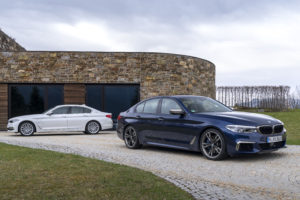
BMW M550i xDrive and BMW 530e iPerformance – image courtesy BMW
BMW puts air vents just behind the front wheel wells to allow air to escape after it does the job of cooling the brakes. The diagonal coverings over those vents are silver on the 530e, as are the accents on the door handles. “eDrive” badging on the C-pillars and “iPerformance” badging elsewhere also visibly distinguish this e-variant from its 5-series stablemates.
Of course, a covered charging port sits behind the left front wheel well.
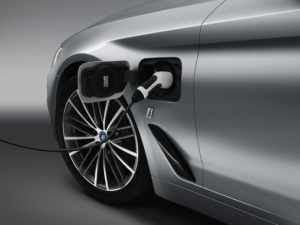
image courtesy BMW
Interior
The dark exterior sets off the ivory-coloured Nappa leather seats through the windshield.
For the first time in a BMW, the infinitely adjustable seats left my head touching the moonroof-enhanced ceiling. It wasn’t overly noticeable while I drove, but the initial impression surprised me. In my experience, BMWs are normally tall-people-friendly, even in the back seat.
The front seats offer massages, and all four are heated AND ventilated, courtesy of BMW’s Interior Comfort Package. (Note: I’ll discuss features throughout this review without always noting which trim level or package they belong to. For more information, see BMW’s website.) The net effect is one of unadulterated pampering.
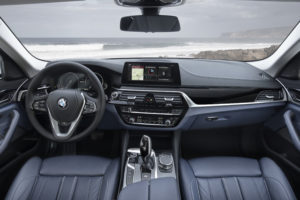
image courtesy BMW
And that’s before you touch anything else in the car. Ceramic controls, leather heated steering wheel, leather surfaces on which to rest your elbows, wood-grain finishes, all of this and more is tastefully interspersed.
Hockey bag test
The 530e passes this test – just. A hump in the trunk just behind the rear seats steals a lot of room, making that part of the trunk much shorter in height and forcing the bag to stay near the trunk lid. I fed my sticks through the middle pass-through of a 40-20-40 split-folding rear seat arrangement.
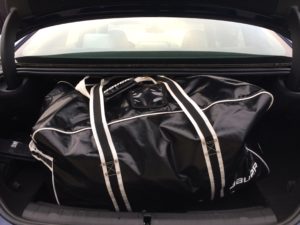
In-cabin technology
BMW simplified the 10.25-inch iDrive display’s home screen, but the menus beyond that screen will be familiar to anybody who has ever used them before.
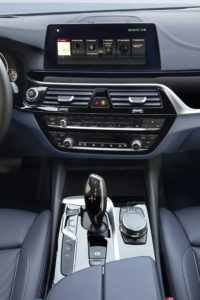
image courtesy BMW
The familiar iDrive controller knob/button/joystick/touchpad continues to provide yeoman service, enabling easy navigation from one screen to the next. The owner of a two-year-old BMW 3-series tells me the buttons surrounding the commander in his car are in different spots compared to the layout in his car, but the shortcuts – navigation, map, etc. – are all still there.
As in the 7-series I drove in 2016, you can change the volume by moving your finger in the air clockwise or counterclockwise in front of the display. You can also dismissively swipe your hand from left to right in front of the screen to, well, dismiss an incoming call. These are three of six possible gestures the infotainment system recognizes. These gestures leave me wondering what other gestures BMW may be developing to spoil drivers even further. I presume all such gestures will remain polite. Meanwhile, 5-series drivers can now amaze passengers using these gestures.
Safety note: you can’t steer the 530e by making gestures in the air. For now.
Apple CarPlay is part of the Smartphone Connectivity Package. My documents didn’t mention Android Auto.
Also part of this package: a small, covered shelf at the base of the centre stack holds a wireless charging surface as well as a USB port. The car itself can also become a WiFi Hotspot.
Silver Harmon-Kardon speakers scattered throughout the car deliver fine audio while also complementing the interior’s upscale look.
The heads-up display largely eliminates the need to look down to the instrument cluster. The speed appears in white numbers until you pass the speed limit, at which point the numbers turn red. BMW calls this “Speed Limit Info” (along with a graphic of a speed limit sign). I call it a subtle nag. But that’s just my opinion.
The all-digital instrument cluster changes appearance depending on the drive mode you choose using the eDrive button on the centre console. These include AUTO eDRIVE, MAX eDRIVE and BATTERY CONTROL. BMW keeps the Sport, Comfort and Eco drive settings in the 530e.
Driving
The internal combustion engine and electric motor combine for off-the-start-line thrills that won’t disappoint performance enthusiasts. The eDrive system’s electric motor puts out 111 hp and maximum torque of 184 lb-ft. The 2.0L 4-cylinder TwinPower Turbo gas engine generates 180 hp and 255 lb-ft maximum torque. Overall numbers are 248 hp and peak torque of 310 lb-ft. BMW claims a 0 to 100 km/h time of 6.1 seconds. Given my experimentation on my favourite on-ramp, I believe it. The slight curve on said on-ramp was of no concern to the xDrive-equipped 530e.
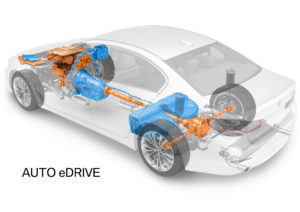
image courtesy BMW
There’s an 8-speed transmission that you can control using the shift lever or paddle shifters, but they seem to defeat the purpose of a hybrid. I didn’t bother with either, focused as I was on the fuel efficiency of the 530e and trusting as I did in the car’s superior ability to choose gears for me.
On my second drive with the 530e, I set the car to draw power mainly from the battery. The main screen warned me of “reduced power” and that’s putting it mildly. Still, that’s often part of economical driving.
When I first started the car after unplugging it from a charging stand in BMW Canada’s parking lot, the 530e’s instrument cluster told me the battery would last 24 km based on the preceding driver’s habits. Regrettably, I didn’t have the opportunity to charge the vehicle myself during my time with it, so I could not have it generate that statistic for me.
For much of my week with the 530e, I let the car choose when to use electric power and when to rely more on the internal combustion engine. As you might guess from the preceding paragraph, this didn’t happen often. I couldn’t charge the battery anywhere I went. I’ve given up lobbying for charging stations in my condo’s underground garage, but that’s a rant for another time.
There’s no torque converter since the electric drive machinery is upstream from the transmission. That setup lessens the extra weight any additional drive unit adds to a vehicle.
Rear passengers sit just above the 9.2kWh lithium-ion-celled battery. It charges in about 7 hours from a 120V outlet using the included “occasional use cable” (OUC). BWM offers a charging station that takes charging time down to less than three hours.
Dynamic cruise control with stop and go is making its way into every carmaker’s lineup, so it seems almost pedestrian to mention it here. Still, the times I was regrettably stuck in traffic during my week with the 530e made me hope that active cruise spreads even farther than it already has in the automotive world.
BMW’s system supports coasting, whether in cruise or not, to save a little fuel and charge the battery. If you’ve driven an electric car, you’ll recognize the familiar braking effect when you lift your foot off the accelerator.
BMW also solved a dynamic cruise control shortcoming I experienced on another vehicle. During a snowy April drive in that other vehicle, the system flashed a message on the instrument cluster of said vehicle telling me the system turned itself off and I had to resume control of the pedals. My group and I made a fuel stop, where we smacked the front bumper to shake off the ice that had accumulated there, and the cruise system worked again when we got back on the road. On the 530e, heating elements ensure that the front-mounted radar sensor remains fully operational even if it’s snowing.
A driver moving quickly behind me on a highway triggered an unintentional test of the cooperation between several active safety systems. Ordinarily, if the forward-facing camera “sees” you’re leaving your lane, the Active Lane Keeping Assistant system gently steers you back in line. I was changing lanes, turn signal and all, when the 530 steered me back into my lane. Active blind spot detection, active lane keeping and side collision avoidance ensured the driver coming up behind me and changing lanes into the lane beside mine did not make contact with the 530e’s lovely paint job.
I had no opportunity to test Evasion Aid, which would have taken evasive action for me if the driver ahead braked unexpectedly. Frankly, I’d rather not test that system.
On a more pedestrian note, the 530e takes 91-grade fuel in its 46-litre tank.
Conclusions
The 530e’s owner’s manual, more than most, reads like a software guide. Each time I get into another BMW, I cover features I left out of a previous review while attempting to do justice to new features I haven’t seen before, all while trying to keep my reviews from taking all day to read. I’ve come to accept that I’ll likely never catch up to every innovation included in these vehicles. But I’ll enjoy them, and their luxurious ride, all the same.
My tester’s base MSRP of $66,900 rose to $82,750 with the addition of several packages.